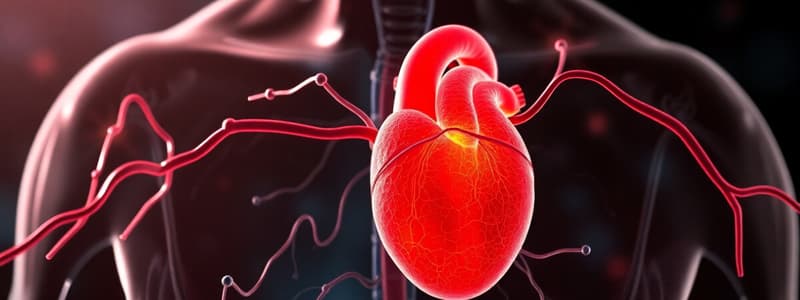Podcast
Questions and Answers
What is the typical concentration range for hormones in the biomedical context?
What is the typical concentration range for hormones in the biomedical context?
- 1–10 mol/L
- 10–15 to 10–9 mol/L (correct)
- 10–12 to 10–11 mol/L
- 10–6 to 10–3 mol/L
Which of the following is a primary role of hormones?
Which of the following is a primary role of hormones?
- Regulating various physiological functions (correct)
- Acting as a source of energy
- Stimulating muscle growth exclusively
- Only influencing mood and emotion
Which concentration level would be considered in the nanomolar range for hormones?
Which concentration level would be considered in the nanomolar range for hormones?
- 10–9 mol/L (correct)
- 10–6 mol/L
- 10–3 mol/L
- 10–12 mol/L
How does hormone concentration typically vary in biological systems?
How does hormone concentration typically vary in biological systems?
Which factor is NOT related to the biological importance of hormones?
Which factor is NOT related to the biological importance of hormones?
Which component is specifically identified as an effector in the described system?
Which component is specifically identified as an effector in the described system?
What is the characteristic of Guanyl Cyclase mentioned in the content?
What is the characteristic of Guanyl Cyclase mentioned in the content?
Which one of the following is categorized as an atriopeptin?
Which one of the following is categorized as an atriopeptin?
What initiates the activation process in the discussed systems?
What initiates the activation process in the discussed systems?
Which statement best describes the roles of receptors and effectors in the system discussed?
Which statement best describes the roles of receptors and effectors in the system discussed?
What enzyme is responsible for hydrolyzing cGMP to 5' AMP?
What enzyme is responsible for hydrolyzing cGMP to 5' AMP?
Which of the following correctly describes the function of Protein Kinase (PKG)?
Which of the following correctly describes the function of Protein Kinase (PKG)?
What happens to unutilized MIT and DIT in the cell?
What happens to unutilized MIT and DIT in the cell?
What is the role of Atrial Natriuretic Factor (ANF) in relation to cGMP?
What is the role of Atrial Natriuretic Factor (ANF) in relation to cGMP?
In the context of cGMP signaling, what does the term 'termination' refer to?
In the context of cGMP signaling, what does the term 'termination' refer to?
Where does the conversion of T4 to T3 primarily occur?
Where does the conversion of T4 to T3 primarily occur?
What is the primary role of deiodinase in the context of thyroid hormones?
What is the primary role of deiodinase in the context of thyroid hormones?
What is the product of cGMP hydrolysis by phosphodiesterase?
What is the product of cGMP hydrolysis by phosphodiesterase?
Which statement about thyroid hormones is correct?
Which statement about thyroid hormones is correct?
Which of the following is a consequence of deiodinase activity?
Which of the following is a consequence of deiodinase activity?
What effect do elevations of cytosolic Ca 2+ have on calmodulin?
What effect do elevations of cytosolic Ca 2+ have on calmodulin?
What is the role of active calmodulin in cellular signaling?
What is the role of active calmodulin in cellular signaling?
Which of the following statements about G-proteins is correct?
Which of the following statements about G-proteins is correct?
What triggers the activation of protein kinase C (PKC)?
What triggers the activation of protein kinase C (PKC)?
How does the increase of cytosolic Ca 2+ influence cellular functions?
How does the increase of cytosolic Ca 2+ influence cellular functions?
Study Notes
Thyroid Hormones
- Range from 10–15 to 10–9 mol/L (Femto to Nanomolar Range)
- Hormones are important for a variety of functions
- MIT & DIT not utilized are deiodinised by deiodinase & reutilized inside the cell
Conversion of T4 to T3
- T4 converts to active T3 in peripheral tissue
Amino Acid Derived Hormones
- G-protein activation has a direct action on Ca 2+ channels
- Elevations of cytosolic Ca 2+ activates Ca2+ Calmodulin
- Active Calmodulin activates Protein Kinase C (PKC)
Atrial Natriuretic Factor (ANF)
- Components: receptor, and effector
- Effector is guanyl cyclase
- Guanyl cyclase can be membrane-bound or soluble
- Atriopeptins are like ANF
- ANF is also known as Atrial Natriuretic Peptide (ANP)
ANF Initiation (Activation)
- ANF activates protein kinase (PKG) which is cGMP dependent kinase
ANF Termination (Inactivation)
- Phosphodiestrase (PDE) hydrolyzes cGMP to 5' AMP
Studying That Suits You
Use AI to generate personalized quizzes and flashcards to suit your learning preferences.
Related Documents
Description
This quiz covers the essential aspects of thyroid hormones, their conversion, and the role of Atrial Natriuretic Factor (ANF) in physiological processes. You will explore the mechanisms of hormone action, including amino acid-derived hormones and their effects on cellular activities. Test your knowledge on the intricacies of these hormones and their biological significance.




